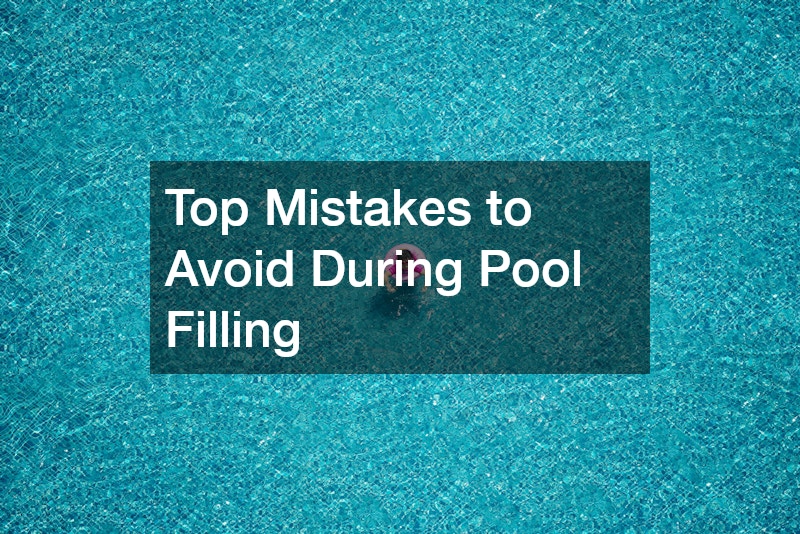Swimming pools are a source of enjoyment and relaxation for many families and individuals. However, the upkeep and maintenance of a pool require careful attention to detail. One of the most crucial maintenance tasks is pool filling, and doing it correctly can prevent many future hassles.
Pool filling may initially appear to be a simple task, yet it is laden with opportunities for error. To avoid these, it is essential to be aware of the common mistakes that can occur.
Addressing these can ensure that your pool remains a clean, safe, and enjoyable environment.
Throughout this article, we will guide you through the top mistakes to avoid during the pool filling process, ensuring that your pool remains in top condition for years of enjoyment. Keep in mind that the proper execution of these steps maintains both the integrity of your pool and the safety of its users.
Incorrect Water Chemistry
One prevalent mistake during pool filling is neglecting to balance the water chemistry. Proper chemical levels are crucial to maintaining a healthy swimming environment, preventing waterborne illness and damage to the pool surface. It is vital to conduct water testing after filling and add the necessary chemicals to balance pH, alkalinity, and calcium hardness.
Ignoring water chemistry can result in negative consequences such as algae growth, cloudy water, and skin irritations for swimmers. Persistent imbalances can lead to scaling on the pool surface and corrosion of pool equipment. Regular testing and adjustment of chemicals will help prolong the life of your pool while ensuring a pleasant swimming experience.
Investing in a quality pool test kit or utilizing professional pool services can streamline the process of maintaining the correct chemical balance. Using these tools, you can detect and resolve imbalances before they develop into costly issues. Remember, a proactive approach to water chemistry is a small investment for peace of mind and pool enjoyment.
Overfilling the Pool
Another frequent error is overfilling the pool, which can cause issues with pool equipment and water overflow. When a pool is overfilled, the water can damage surrounding structures or cause imbalances in the filtration system. It is important to fill the pool to the recommended level, generally halfway up the skimmer opening.
Overfilling can also result in water wastage—a concern for both your water bill and the environment. To avoid this, closely monitor water levels during the filling process and use a timer or automatic shut-off valve for assistance. Ensuring the correct water level helps maintain the balance necessary for the efficient operation of your pool systems.
If your area is prone to heavy rain, it is wise to keep the water level slightly below the recommended mark to accommodate additional rainfall. Taking these preventive measures will prevent unnecessary stress on your pool and reduce maintenance costs. Keep this in mind, and you’ll enjoy a healthier and better-functioning pool.
Ignoring Local Regulations
A common mistake homeowners make is neglecting to check local regulations before beginning the pool filling process. Specific areas have rules regarding water usage, especially during drought conditions, which can result in fines if ignored. Understanding these regulations helps prevent legal issues and ensures responsible water usage.
Local water authorities often provide guidelines on the optimal times to fill your pool and any permits needed. Investigating these before beginning the fill can prevent potential interruptions and penalties. By keeping abreast of the local regulations, pool owners can contribute to community conservation efforts.
Additionally, some municipalities have water treatment requirements in place to protect the local ecosystem. Discuss these with local officials, as compliance ensures that garden and pool water runoff remains safe for nearby streams and wildlife. Ensure you fill your pool responsibly so your enjoyment doesn’t negatively impact the environment.
By avoiding these common pool filling mistakes, pool owners can ensure the longevity and safety of their swimming pool. Proper water chemistry, adequate water levels, and compliance with local regulations are essential components of a successful pool maintenance regimen. Adopting a proactive approach will aid in sidestepping these issues, allowing for more enjoyable and worry-free pool days.
The satisfaction of relaxing in a well-maintained pool is well worth the effort invested in avoiding these mistakes. Each step you take toward correctly filling your pool will lead to safer and more pleasant swimming experiences. With these tips in mind, you can look forward to many seasons of sun-filled enjoyment by the poolside.
Remember, a thorough understanding and application of pool maintenance best practices start with the filling process. By adhering to these guidelines, you set the foundation for a hassle-free and enjoyable pool ownership experience. Use this knowledge to fill your pool efficiently and maintain a sparkling oasis for family and friends.

